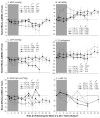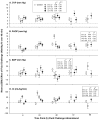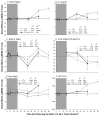Anthrax lethal and edema toxins produce different patterns of cardiovascular and renal dysfunction and synergistically decrease survival in canines
- PMID: 21067373
- PMCID: PMC3061475
- DOI: 10.1086/657408
Anthrax lethal and edema toxins produce different patterns of cardiovascular and renal dysfunction and synergistically decrease survival in canines
Abstract
Background: High mortality in the 2001 US and recent European anthrax outbreaks suggests that better understanding of the effects of the toxins produced by this bacterium is needed to improve treatment.
Methods and results: Here, 24-h edema (ETx) and lethal (LeTx) toxin infusions were investigated for 96 hin sedated canines receiving mechanical ventilation. The initial study compared similarly lethal doses of ETx (n=8) or LeTx (n=15) alone. ETx was 24 times less lethal than LeTx, and the median time to death in nonsurvivors (n=6 and n=9, respectively) was shorter with ETx (42 vs 67 h; P=.04). Compared with controls(n=9), both toxins decreased arterial and central venous pressures and systemic vascular resistance and increased heart rate, cardiac index, blood urea nitrogen (BUN) level, creatinine (Cr) concentration, BUN:Cr ratio, and hepatic transaminase levels (P ≤ .05 for toxin effect or time interaction). However, ETx stimulated early diuresis,reduced serum sodium levels, and had more pronounced vasodilatory effects, compared with LeTx, as reflected by greater or earlier central venous pressures, systemic vascular resistance, and changes in the BUN:Cr ratio(P ≤ .01). LeTx progressively decreased the left ventricular ejection fraction (P ≤ .002). In a subsequent study, a lethal dose of LeTx with an equimolar nonlethal ETx dose (n=8) increased mortality, compared with LeTx alone (n=8; P= .05).
Conclusion: Shock with ETx or LeTx may require differing supportive therapies, whereas toxin antagonists should likely target both toxins.
Figures








References
-
- Barakat LA, Quentzel HL, Jernigan JA, et al. Fatal inhalational anthrax in a 94-year-old Connecticut woman. JAMA. 2002;287:863–868. - PubMed
-
- Health Protection Scotland. Anthrax outbreak information. [Accessed 22 February 2010]. http://www.hps.scot.nhs.uk/anthrax/
-
- BBC News. German death linked to Scots anthrax outbreak. [Accessed 22 February 2010]. http://news.bbc.co.uk/2/hi/uk_news/scotland/glasgow_and_west/8500848.stm.
-
- Collier RJ, Young JA. Anthrax toxin. Annu Rev Cell Dev Biol. 2003;19:45–70. - PubMed
Publication types
MeSH terms
Substances
Grants and funding
LinkOut - more resources
Full Text Sources
Medical

